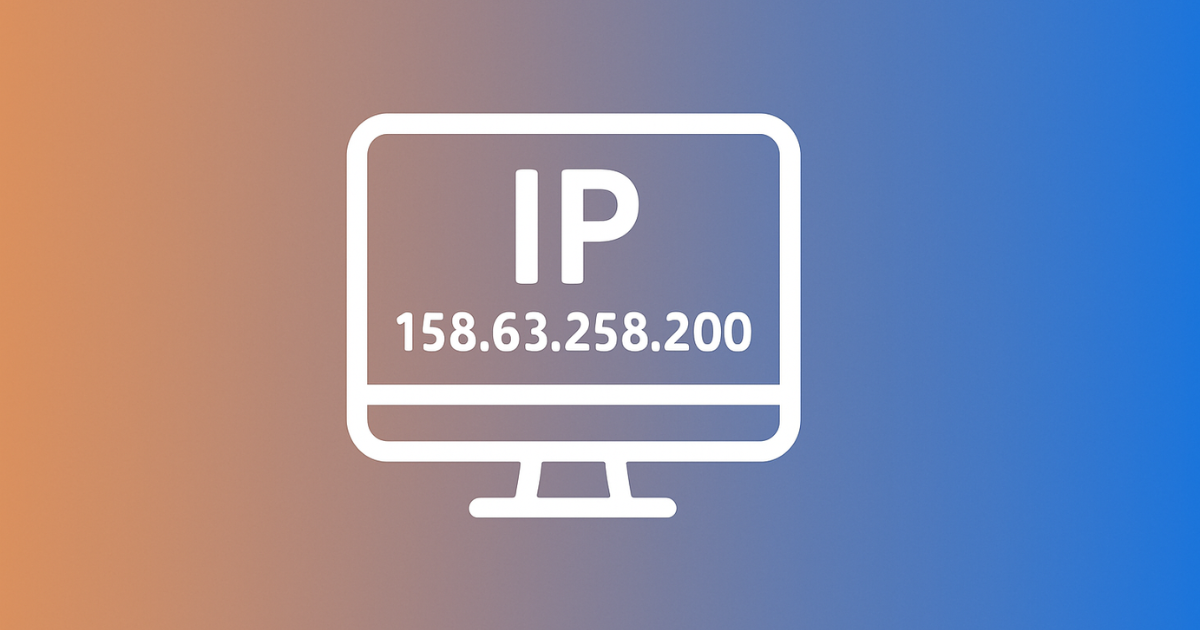In the vast expanse of the internet, every device is identified by a unique numerical label known as an IP address. One such intriguing example is 158.63.258.200. But what does this series of numbers mean? As we dive deeper into the world of networking and technology, understanding IP addresses becomes essential for navigating online spaces effectively.
Whether you’re a casual web surfer or an aspiring tech guru, knowing about IP addresses like 158.63.258.200 can enhance your digital literacy and help demystify how devices communicate in our interconnected world.
Let’s embark on this exploration together and uncover the significance behind these seemingly random numbers!
What is 158.63.258.200?
The IP address 158.63.258.200 is a numerical label used to identify devices on a network. Each device connected to the internet requires a unique identifier, and this is where IP addresses come into play.
This specific address falls under the category of IPv4, which stands for Internet Protocol version 4. It consists of four sets of numbers separated by periods.
However, it’s important to note that 158.63.258.200 isn’t valid due to its third segment exceeding the maximum value of 255 for any octet in an IPv4 address.
Despite being improperly formatted, discussing such examples can help users understand how IP addresses operate and why they are crucial for online communication and connectivity across various platforms globally.
How IP addresses are assigned
IP addresses are assigned through a system that ensures every device connected to the internet has a unique identifier. The Internet Assigned Numbers Authority (IANA) oversees this process globally. They allocate large blocks of IP addresses to regional registries.
Each regional registry, in turn, distributes these addresses to Internet Service Providers (ISPs). ISPs then assign them to individual customers or businesses. This hierarchical structure helps manage the vast number of devices online today.
Dynamic and static assignments are two primary methods used by ISPs. Dynamic IPs change periodically, while static ones remain constant over time. This distinction affects how devices communicate and connect within networks.
The assignment process is crucial for maintaining order on the internet. Without it, conflicts would arise as multiple devices attempted to use the same address simultaneously.
The importance of IP addresses in the digital world
IP addresses serve as the backbone of our digital connectivity. Every device connected to the internet requires a unique identifier, and that’s where IP addresses come into play.
These numerical labels allow devices to communicate effectively. Without them, navigating the vast expanse of the internet would be nearly impossible.
They facilitate everything from sending emails to streaming videos. Imagine trying to watch your favorite show online without an IP address directing data packets back and forth!
Additionally, IP addresses help in locating users geographically, enabling services like targeted advertising or localized content delivery. This functionality enhances user experience while allowing businesses to reach their intended audience more efficiently.
Security is another vital aspect tied to IP addresses. They can be monitored for unusual activity, helping protect networks from potential threats and ensuring safer browsing experiences for everyone involved.
Different types of IP addresses and their uses
IP addresses come in various types, each serving distinct purposes. The most common are IPv4 and IPv6.
IPv4 is the traditional format, consisting of four sets of numbers separated by periods. It offers about 4 billion unique addresses but has become increasingly insufficient due to the internet’s rapid growth.
On the other hand, IPv6 was developed to address this limitation. With its longer format, it provides an almost limitless number of IPs—3.4 x 10^38 to be exact. This guarantees that our connected world can keep expanding without running out of addresses.
Static IP addresses remain constant over time, ideal for servers and hosting websites. Dynamic IPs change periodically and are often used by households to connect multiple devices seamlessly through a single connection.
Each type plays a critical role in how we navigate online spaces every day.
Common misconceptions about IP addresses
Many people think that IP addresses are static and never change. In reality, most devices use dynamic IP addresses which can be reassigned frequently by Internet Service Providers (ISPs). This leads to a fluid internet experience.
Another misconception is that knowing an IP address reveals personal information about the user. While it can indicate geographical location, it won’t provide specific details like names or addresses.
Some believe that all IPs are public and easily accessible. However, many devices operate on private networks with internal IPs not visible to the outside world.
There’s confusion around IPv4 and IPv6. The former consists of 32-bit addresses leading to limited availability. IPv6 was developed to expand this capacity significantly, ensuring more unique identifiers for our ever-growing online activities.
Conclusion: Understanding the significance of 158.63.258.200 in the world of networking and technology
Understanding the significance of 158.63.258.200 in the world of networking and technology reveals much about our digital landscape. This IP address, like many others, plays a critical role in facilitating communication between devices on the internet. It serves as an identifier, allowing data to be routed correctly across complex networks.
As we navigate through various online services and platforms, every action relies on these invisible numbers to function seamlessly. While specific details about 158.63.258.200 might not be readily available due to its potential status as an unassigned or invalid address, its discussion opens up broader conversations regarding IP allocations and their implications for network security.
IP addresses have become foundational elements of how we connect today—impacting everything from web hosting to cybersecurity measures. Recognizing this allows us to appreciate the intricate connections that enable our daily digital interactions.
The exploration of any particular IP address highlights the need for awareness of our online presence and privacy concerns associated with it. Understanding these nuances enriches our comprehension of technology’s continuous evolution and emphasizes why even seemingly random numbers hold significant value in today’s interconnected world.

















